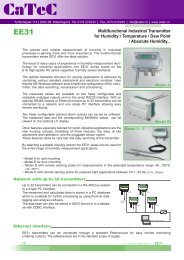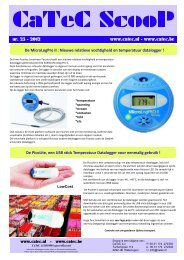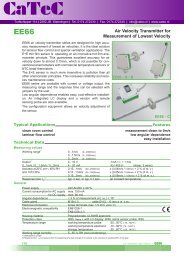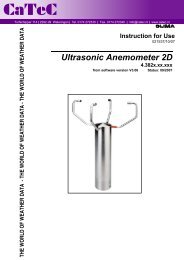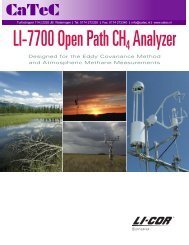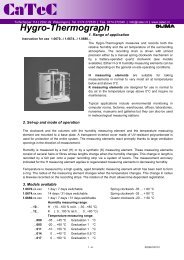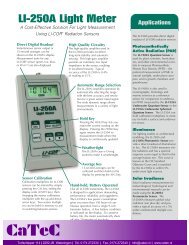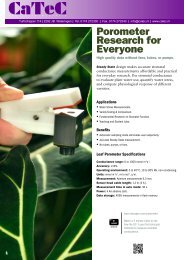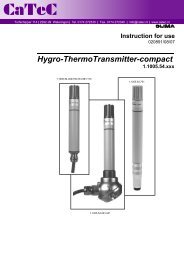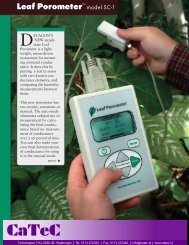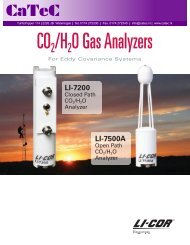li-190sa quantum sensor li-190sa quantum sensor
li-190sa quantum sensor li-190sa quantum sensor
li-190sa quantum sensor li-190sa quantum sensor
You also want an ePaper? Increase the reach of your titles
YUMPU automatically turns print PDFs into web optimized ePapers that Google loves.
Spatial Error<br />
This error is caused by a <strong>sensor</strong> not responding to radiation at<br />
various incident angles. Spatial error consists of the cosine error<br />
(or the angular error) and azimuth error.<br />
Cosine Error<br />
A <strong>sensor</strong> with a cosine response (follows Lambert's cosine<br />
law) allows measurement of flux densities through a given<br />
plane, i.e. flux densities per unit area. When a parallel beam<br />
of radiation of given cross-sectional area spreads over a flat<br />
surface, the area that it covers is inversely proportional to<br />
the cosine of the angle between the beam and a plane nor<br />
mal to the surface. Therefore, the irradiance due to the beam<br />
is proportional to the cosine of the angle. A radiometer,<br />
whose response to beams coming from different directions<br />
follows the same relationship, is said to be "cosine-corrected"<br />
(6). A <strong>sensor</strong> without an accurate cosine correction can<br />
give a severe error under diffuse radiation conditions within<br />
a plant canopy, at low solar elevation angles, under fluorescent<br />
<strong>li</strong>ghting, etc.<br />
Cosine response is measured by placing the <strong>sensor</strong> on a<br />
platform which can be adjusted to rotate the <strong>sensor</strong> about an<br />
axis placed across the center of the measuring surface. A<br />
col<strong>li</strong>mated source is directed at normal incidence and the<br />
output of the <strong>sensor</strong> is measured as the angle of incidence is<br />
varied. The cosine error at angle 0 is the percent difference<br />
of the ratio of the measured output at angle 0 and normal<br />
incidence (angle 0°) as compared to the cosine of angle 0.<br />
This is repeated for various azimuth angles as necessary.<br />
The LI-190SA, LI-200SA and LI-210SA are fully corrected<br />
cosine <strong>sensor</strong>s. These <strong>sensor</strong>s have a typical cosine error of<br />
less than 5% up to an 80° angle of incidence. Totally diffuse<br />
radiation introduces a cosine error of approximately 2.5%.<br />
For sun plus sky at a sun elevation of 30° (60° angle of<br />
incidence), the error is ≈2%. The LI-192SA <strong>sensor</strong> has a<br />
s<strong>li</strong>ghtly greater cosine error since this <strong>sensor</strong> has a cosine<br />
response optimized for both air and water. The LI-191SA<br />
uses uncorrected acry<strong>li</strong>c diffusers and has a greater error at<br />
high angles of incidence. For totally diffuse radiation, the<br />
error is ≈8%. For conditions within canopies, the error is<br />
less because the radiation is not totally diffuse.<br />
Angular Error<br />
A spherical PPFFR <strong>sensor</strong> measures the total flux<br />
incidence on its spherical surface divided by the crosssectional<br />
area of the sphere. Angular error is measured by<br />
directing a col<strong>li</strong>mated source at normal incidence and<br />
rotating the <strong>sensor</strong> 360° about an axis directly through the<br />
center of the sphere at 90° from normal incidence. This is<br />
repeated for various azimuth angles as necessary to<br />
characterize the <strong>sensor</strong>.<br />
The LI-193SA angular error is due to variations in density<br />
in the diffusion sphere and the sphere area lost because of<br />
the <strong>sensor</strong> base (Figure 2). This error is less than -10% for<br />
total because the upwel<strong>li</strong>ng radiation is much smaller than<br />
the downwel<strong>li</strong>ng radiation.<br />
Azimuth Error<br />
This is a subcategory of both cosine and angular error. It is<br />
specified separately at a particular angle of incidence. This<br />
error is the percent change of the <strong>sensor</strong> output as the <strong>sensor</strong><br />
is rotated about the normal axis at a particular angle of<br />
incident radiation. This error is less than ±1% at 45° for the<br />
LI-190SA, LI-192SA, LI-200SA, and LI-210SA <strong>sensor</strong>s.<br />
The error is less than ±3% for the LI-191SA and LI-193SA<br />
<strong>sensor</strong>s.<br />
Displacement Error<br />
In highly turbid waters, the LI-193SA Spherical Sensor will indicate<br />
high PPFFR values due to the displacement of water by the<br />
<strong>sensor</strong> sphere volume. This is because the point of measurement<br />
is taken to be at the center of the sphere, but the attenuation<br />
which would have been provided by the water within the sphere<br />
is absent. This error is typically +6% for water with an attenuation<br />
coefficient of 3 m -1 (2).<br />
Tilt Error<br />
Tilt error exists when a <strong>sensor</strong> is sensitive to orientation due<br />
to the effects of gravity. This exists primarily in thermopile<br />
type detectors. Si<strong>li</strong>con type detectors do not have this error.<br />
All LI-COR <strong>sensor</strong>s are of the latter type and have no tilt error.<br />
This error in the LI-200SA Pyranometer is nonexistent and has<br />
an advantage over thermopile type detectors for solar radiation<br />
measurements (3).<br />
Linearity Error<br />
Linearity error exists when a <strong>sensor</strong> is not able to follow proportionate<br />
changes in radiation. The type of si<strong>li</strong>con detectors used in<br />
LI-COR <strong>sensor</strong>s have a <strong>li</strong>nearity error of less than ±1% over<br />
seven decades of dynamic range.<br />
Fatigue Error<br />
Fatigue error exists when a <strong>sensor</strong> exhibits hysteresis. This is<br />
common in selenium-based illumination meters and can add a<br />
considerable error. For this reason, LI-COR <strong>sensor</strong>s incorporate<br />
only si<strong>li</strong>con detectors which exhibit no fatigue error.<br />
Temperature Coefficient Error<br />
Temperature coefficient error exists when the output of a <strong>sensor</strong><br />
changes with a constant input. This error is typically less than<br />
±0.1% per °C for the LI-190SA, LI-191SA, LI-192SA,<br />
25



